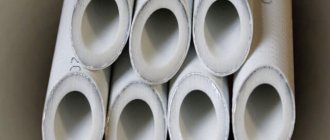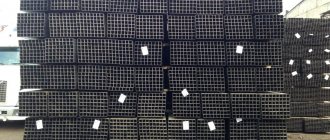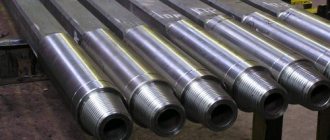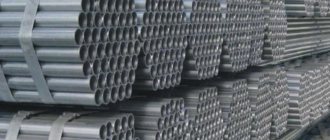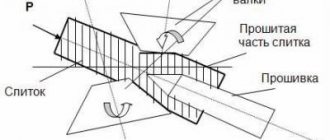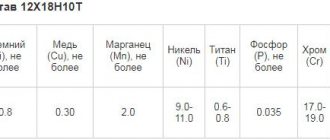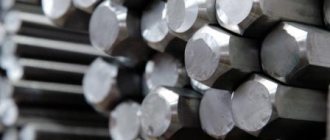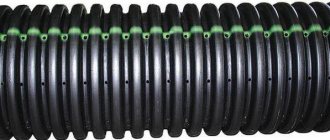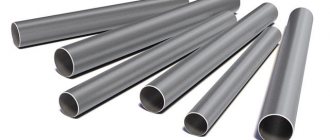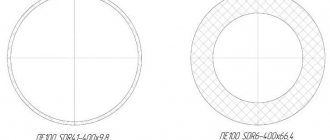What can be used for marking?
For marking the following can be used:
- Indelible paint.
- Electrographs.
- Electric inkjet printing devices.
- Branding.
No data is applied to some types of pipe products, and for those that must have markings, the marking method is selected depending on the grade and main parameters of the pipe.
Standard marking of steel pipes
All necessary data is applied to the pipes according to a certain standard.
Location of symbols
Manual marking of a steel pipe is printed at a certain distance from the end of the product: no less than 2 cm and no further than 50 cm. With mechanized marking, this value increases and is 0.1 m and 1.5 m.
Symbol size
The letter and numerical designations of the pipe must have a certain size, which is also regulated by a certain regulatory document. Signs must have a height of no less than 0.5 cm and no more than 3 cm, and a width from 0.3 cm to 1.2 cm. The size of the signs is determined in accordance with the parameters of the pipe.
Division into classes
Conventionally, pipe products are divided into the following classes:
- Class 1 pipes can be used for gaseous and liquid media in irrigation systems. In addition, it is possible to manufacture fencing structures or supports from such products.
- Class 2 pipes can be used in pipelines operating at low and high pressure, transporting oil and petroleum products, gas or water.
- Class 3 pipes are suitable for work at high temperatures.
- Class 4 includes thick-walled drill pipes that can resist strong torsion.
- Class 5 pipes are used in the construction of carriages, cars, overhead cranes, drilling rigs and some furniture structures.
- Class 6 pipes are used in the engineering industry as blanks from which bearings, cylinders, pumps and receivers are produced.
Stamp size
The height of the signs is from 5 to 30 mm, the width is from 3 to 12 mm - depending on the size of the pipe.
Classification
There is a conditional division into six classes:
1 class - used for transporting low-pressure liquid and gaseous substances in irrigation systems. They make fences and supports, scaffolding, etc.
2 class - used in low and high pressure pipelines, for supplying petroleum products, gas and water.
3 class - works in conditions of high temperatures under pressure: heating boilers, petroleum cracking, nuclear technology.
4 class - thick-walled drill pipes that can withstand high torsional loads. They are used in the development of oil fields and other geological work.
5 The class is used in transport construction: carriages, cars, overhead cranes, drilling rigs and in furniture construction.
Class 6 – blanks used in mechanical engineering for the manufacture of: bearings, pump cylinders, receivers, etc.
The diameter of the pipe is distinguished as follows:
| Straight-seam steel pipes chtpz-sale.ruHigh-quality pipes at manufacturer prices. Online ordering on the website. About the companyContactsLarge catalogOur clientsHide ad |
- Up to 114 mm – small diameter pipes;
- From 114 mm to 480 mm – medium;
- From 480 mm – large.
Diameter of steel pipes according to GOST R
Small diameter (up to 114 mm.).
Small diameter pipes are not marked. An accompanying label with information is attached to them. The same applies to cold-deformed pipes up to 450 mm - they are transported in bags, and a label is attached to the entire bag.
The label contains the following information:
Small diameter pipes with information label
- Recipient's name;
- Order No.;
- Date/shift;
- Package No.;
- Batch number;
- Size;
- Standard (TU or GOST);
- Steel grade;
- Heat number;
- Pieces (number of units in the package);
- Theoretical weight kg. (if the order is in meters);
- Actual weight;
- Meters (total length);
- Recipient code.
Medium diameter (114 – 480 mm)
Pipes with a wall thickness of 3.5 mm and a diameter of 159 mm are marked each separately. Cold-deformed pipes from 159 – 450 mm, as a rule, three products from the entire package are marked and a label is attached.
Large diameter (from 480 mm)
Marking with a diameter of 530 mm or more is allowed on the inner surface.
If the wall thickness is more than 10 mm, marking on the end of the pipe is possible.
The color of the paint may indicate the grade of steel from which the pipe is made
Example of boiler pipe marking color:
Steel grade:
- 20 – green;
- 20PV – blue;
- 15GS – brown;
- 15ХМ – yellow;
- 12Х1МФ – red;
- 12Х1МФ-ПВ – orange;
- 15Х1М1Ф – white;
- 12Х2МФСФ – blue.
An example of paint marking of a seamless casing pipe with a threaded connection in accordance with GOST 632.
The combination of numbers “146 (E) 7.7 1083 304 OTTM A” means:
- 146 – diameter;
- (E) – strength group. “E” in brackets means that ultrasonic testing has been performed;
- 7.7 – wall thickness;
- 1083 – length (then there is an indentation of 30-35 mm);
- 304 – mass;
- OTTM – type of connection (short triangular thread is not indicated);
- A – execution (written only if option A);
- At the end is the plant's trademark.
Classification by diameter
It is necessary to understand what diameters of steel pipes there are in order to know what you will have to choose from. Depending on the diameter, special-purpose pipes are also divided into several types:
- Small diameter pipes have a cross-section of no more than 114 mm.
- Medium diameter products – over 114 mm, but not more than 480 mm.
- Large diameter pipes have a cross section greater than 480 mm.
Small diameter pipes
Products of this type are not marked; they are transported in special packaging with an accompanying label. In a similar way, data is applied to pipes obtained in the process of cold deformation with a diameter of no more than 450 mm.
Products must be accompanied by the following information:
- Manufacturer information and order number.
- Date of manufacture and changeover information.
- Package number.
- Batch number.
- Dimensions, including designation of pipe wall thickness.
- Regulatory document.
- Melt number.
- Number of units in one package.
- Theoretical weight (indicated in meters when ordering).
- Actual weight.
- Total footage.
- Recipient code.
Medium diameter pipes
Products whose wall thickness exceeds 3.5 mm and whose diameter exceeds 159 mm are individually marked. Cold-formed pipes with a diameter of more than 159 mm and less than 450 mm are designated on three units of the entire package, and are also accompanied by a special label.
Large diameter pipes
Products with a diameter exceeding 530 mm may have markings inside the pipe.
Read also: Dimensions of gas cylinders for cars table
If the wall thickness is more than 10 mm, then markings can be applied to the end of the products. Depending on the grade of steel used in the production of pipes, the color of the marking is selected. Most often, the pipe symbol is brightly colored to make it easier to find.
Pipes for boiler rooms, in accordance with the steel grade, are designated in the following colors:
- Green markings are applied to grade 20 steel.
- Blue markings are for steel grade 20PV.
- Brown letters and numbers correspond to 15GS steel.
- Yellow markings can be seen on steel grade 15ХМ.
- Orange markings are applied to steel 12Х1МФ-ПВ.
- The data on the pipe, printed in white, corresponds to steel 15Х1М1Ф.
- Blue letters and numbers are applied to 12Х2МФСФ pipes.
How to read the designation of water and gas pipes
To distinguish the purpose of pipes and know all their properties, markings in the form of alphanumeric designations were invented. She points to:
- manufacturing and coating material
- pipe diameter
- wall thickness
- accuracy class
- presence of thread
- presence of a coupling
The material used to make a water and gas pipe is always steel, but it can be black or galvanized. In the case of galvanized pipes, the marking contains the designation (C).
The nominal diameter of the control valve is the main parameter; it can be in the range of 6-150 millimeters or more.
The wall thickness depends on the diameter of the VGP pipe and can vary between 1.8-4 mm, although there is an exception - a reinforced pipe can have a thickness of up to 5.5 and even 10 mm. When marking pipes, the actual number of wall thickness is indicated - (1.8 or 4, or 5.5, etc.).
The accuracy class of the pipe can be increased or normal. An upgraded class is indicated by the letter (P).
The presence of threads is indicated by letters indicating rolled (H) threads at the ends and threaded threads (P). If the thread is elongated, then an additional designation (D) is given. If there are no threads on the pipes, then there are no markings.
The presence of a coupling on the pipe adds the designation (M) to the marking.
So, the designation on the pipe - Ts-R-150x5.5 GOSTXXXX-XX means:
- C - galvanized pipe
- P - with thread
- 150 - diameter in millimeters
- 5.5 - wall thickness in millimeters
- GOSTХХХХ-ХХ. - manufactured according to GOST
Designations are applied by branding at a distance of 20-500 millimeters from the end on pipes with a diameter of 159 mm and a wall thickness of 3.5 mm. Pipes of smaller diameter are not marked; information about them is placed on a label attached to the pipe package. Often the markings on pipes are outlined in a bright color for better visibility.
What is the service life of water and gas pipes?
Steel pipes are a durable material, sometimes almost eternal. Their service life directly depends on the conditions in which they are used. Made of black steel and without an anti-corrosion coating - not galvanized, they last a long time in cold water, but eventually their gaps become overgrown, and the threads begin to leak due to the thinning of the walls under the threads.
Pipes made of black steel and used for gas pipelines in non-damp conditions can last for centuries.
If the material used to make water pipes is corrosion-resistant steel, then they last for an almost unlimited time.
Source: samanka.ru
Designation according to the new national standard
According to the new regulatory document GOST R ISO 3183-1-2007, pipe elements have some differences in marking.
Pipes with a diameter of less than 48.3 mm are transported in packaging, with the designations printed on a bandage or an attached metal label using the branding method. The length of such products must be indicated in meters and centimeters.
For products with a diameter not exceeding 406.4 mm, markings are applied to the outer surface of each pipe. The length of the product can be indicated anywhere.
Marking of metal pipes with a diameter of over 406.4 mm is carried out inside the pipe. However, at the request of the customer, other options can be used. Products are marked using a stencil, with a deviation from the edge of at least 152.4 mm.
You cannot place a mark next to the weld in the following cases:
- If the pipes are made of steel of strength group L175 and higher without subsequent hardening.
- If the wall thickness of the products does not exceed 4 mm.
This distance from the seam to the stamp must be more than 25.4 mm.
The labeling indicates the following:
- Manufacturer (full name or trademark designation is allowed).
- Designation of the GOST R ISO 3183-1 standard, provided that the product is made in full compliance with this document.
- When manufactured according to several standards, each of them is designated.
- Weight of 1 linear meter of the finished product.
- Steel grade and strength group.
- Methods of product formation.
- Performed heat treatment.
- Tested pressure.
- Various additional requirements.
Steel of a strength group above L320 can be produced with a niobium content, which is indicated in the marking by the letter C, the vanadium content in the steel is indicated by the letter V, and titanium by the letter T.
The method of pipe formation is also reflected in the marking:
- Seamless pipes are designated by the letter S.
- Welded products with a continuous seam are designated by the letter F.
- The remaining welded pipes are designated W.
Heat treatment also has the corresponding designation:
- The normalized pipe is marked as N.
- Products with subcritical stress removed are designated by the letters HS.
- Pipes cured in a subcritical state are marked HA.
- Quenched and tempered products are marked with the letter Q.
Additional designations include applying a spot of a certain color with a diameter of 5 cm. It is applied to products with a diameter of over 114.3 mm, made of L320 steel.
Each strength group is marked with its own color:
- L320 pipes are marked with a black spot.
- L360 pipes are a green spot.
- Products corresponding to group L390 are marked with a blue spot.
- There is a red stain on the L415 pipes.
- There is a white spot on L450 products.
- L485 pipes have a purple stain.
- L555 pipes are yellow.
It is very important to consider the following: after additional processing of finished pipes, the old markings should be erased.
The couplings are also marked according to a specific standard.
It contains the following information:
- Manufacturer.
- Strength group.
- Corresponding standard.
Pipe threads must also be marked. For this purpose, a stamp is used, which is applied near the thread.
It is not easy to fully understand all the nuances of marking, but even superficial knowledge in this area will help you find out the necessary information about a steel pipe.
Pipes are used to lay a heating or water supply line. These long industrial products are made from different materials.
Read also: Metal engraving tool
They must be reliable to last for many years. VGP pipes are considered very durable and wear-resistant.
International standard GOST R ISO 3183-1-2007
Pipes with a diameter of up to 48.3 mm inclusive are transported in bags, and the marking is applied with a stamp on a bandage or an attached metal label. The total length is indicated in meters and centimeters.
Next, with a diameter of up to 406.4 mm, each pipe is marked with paint using a stencil on the outer surface. The length is indicated anywhere at the discretion of the manufacturer.
With a diameter of 406.4 mm inclusive and more, by default they are marked from the inside, unless the customer has specified another option. Apply using a stencil at a distance of 152.4 mm or more from the end of the pipe.
The stamp is not used to mark pipes closer than 25.4 mm from the weld:
- Steel strength groups above L175 without subsequent hardening;
- With a wall thickness of less than 4 mm.
Marking contains
- Manufacturer's trademark or name;
- Designation of the GOST R ISO 3183-1 standard (applied if the product fully complies);
- If it meets several standards, then all may be indicated;
- Designation of mass per linear meter;
- Steel class and strength group;
- Pipe forming method (S, W, F);
- Performed heat treatment;
- Test pressure (if tested above the standard pressure, this number is indicated in Pascals, after the word TESTED);
- There may be additional requirements.
Steel strength group
L320 and higher, with niobium content the letter C is indicated, vanadium - V, titanium - T.
The formation method or production process is indicated by:
S – seamless pipe; W – welded, except those made with a continuous seam; F – pipe made with a continuous weld.
Heat treatment is indicated by the following signs:
- Tempered and/or normalized pipe – N;
- Subcritical stress relief – HS;
- Subcritically cured – HA;
- Quenched and Tempered – Q.
The supplement includes
A paint spot with a diameter of 50 mm can be applied, which corresponds to the steel strength group, this applies to pipes over 114.3 mm in diameter, strength group L320 and higher.
Table of correspondence:
- L320 - Black color;
- L360 - Green;
- L390 - Blue;
- L415 - Red;
- L450 - White;
- L485 - Violet;
- L555 - Yellow.
Reading example
"X GOST R ISO 3183-1-2007 14 54 57 L245 S"
Let's decipher:
- “X” – trademark;
- "GOST R ISO 3183-1-2007" - GOST;
- "14" - size;
- “54, 57” - mass;
- “L245” - steel strength group;
- "S" - seamless.
If the pipes have been subjected to treatment, such as heat treatment, then any markings that no longer correspond to the condition must be removed.
Couplings for products are also marked in accordance with standards and contain:
- Manufacturer's name;
- Steel strength group;
- Standard designation.
The threads on pipes are marked with a stamp or paint next to the thread; if the manufacturer of the pipe and thread are the same, then the trademark may be omitted.
Thread marking according to GOST is carried out separately and does not give the right to claim that the entire product meets the same standard.
It can be quite difficult to understand all the intricacies of marking, but once you have mastered this “literacy”, one look at a steel pipe will be enough for you to learn everything, or almost everything, about it!
Source: aquacomm.ru
Description and explanation of the abbreviation VGP
For a long time, VGP pipes have been indispensable elements in the construction of many facilities. They are used for supplying communications:
The abbreviation VGP stands for water and gas pipes . They are considered very durable and are equal to the strength of an all-metal beam of identical diameter.
These products are made from carbon steel . They are always in demand, despite the fact that pipeline materials made of plastic and metal-plastic have now appeared. This is due to the fact that there are areas of communication networks where products made from other materials cannot be used. For example, gas pipelines cannot be laid using plastic products.
VGP products are produced using the technology of welding and forming metal strips. Rolled sheets are used as a workpiece. It is made from carbon hot-rolled structural steel. To ensure that such a material can withstand maximum loads, special attention is paid to the weld seam during the production process. Such finished products must be gas and waterproof. Depending on the wall thickness, products are divided into separate types :
- lungs;
- ordinary;
- reinforced.
They are produced in the form of material in measured and unmeasured lengths. Eight-meter long pipes are considered the most popular. There are also products with a length of 5.8; 7.8; 9 and 11.75 meters. Such parameters are related to the peculiarities of transportation and installation.
Why do we need GOST?
Standardization regulates the range of steel products. In other words, it determines the necessary parameters and permissible deviations from them during the pipe production process.
There is a reference book on graded metals. Which describes all the standard values: wall dimensions, length of one or another type of pipe, as well as the weight of the st20 pipe. The weight of steel elements is usually calculated using steel linear meters. This parameter is necessary for calculating the theoretical masses of rolled metal products required for the construction of a specific structure.
Knowing the parameters, you can easily determine the cost of the pipe.
Main advantages
VGP pipes are in demand for the construction of main lines and domestic pipelines. They use gas or water as a working medium. The main advantages of such products are the following indicators:
- low coefficient of linear expansion, which prevents deformation of the structure under the influence of high and very low temperatures;
- high strength compared to polypropylene and many other materials;
- possibility of use in pressure-type structures;
- good thermal conductivity, which has a positive effect on maintaining the temperature of the transported working environment;
- tightness allows the delivery of volatile and gaseous substances, acids and many other chemically active substances through pipes.
A high thermal conductivity coefficient can lead to cooling of the transported working medium. To avoid this, VGP pipes are used with additional thermal insulation materials.
Characteristics
According to the type of product, VGP pipes are divided into two types - black and galvanized steel. The latter type of high-precision products is distinguished by classification according to wall thickness, length, external diameter and nominal bore. They successfully resist corrosion.
Such products are coated with a layer of zinc of at least 30 microns, which increases their service life. The outer diameter of the products ranges from 1.0 to 16.5 cm.
The nominal bore is measured in inches . This allows you to conveniently and easily decide on the selection of additional elements:
Other elements are also selected. The geometric parameters of the pipe are selected according to a special table. It corresponds to the manufactured products in weight and size. In production conditions, such products are manufactured in two modifications:
- without thread;
- with existing threads on both sides, applied by cutting or rolling.
Decoding the numbers in the designations allows you to determine the exact size of the pipe diameter.
There are pipes of ordinary precision. During production, they are not standardized by the following parameters - mechanical characteristics, chemical composition of the material. Such products are successfully used in household communications.
There is also a category of high-precision products. They standardize their chemical composition of the material and mechanical characteristics. This pipeline material is intended for industrial use. It is subject to the highest requirements for strength and reliability.
Application area
VGP products are able to withstand strong hydraulic shocks, as well as thermal deformation of the transported liquid. For domestic purposes they are intended for transportation:
- water (cold and hot);
- low pressure gas.
For water supply, VGP pipes are connected by welding, as well as using threaded connections and other additional parts.
The products have found application in the creation of various metal structures: fences, small architectural forms, scaffolding, cabinets, weights, whatnots. Most of the products are used in the housing and public utilities sector. Almost all apartments and houses use such material to provide them with water, heat and domestic gas. Modern manufacturing companies have the appropriate certificates. This suggests that manufacturers adhere to the standards in a particular GOST.
Read also: How to use a dt 838 multimeter for dummies
There is also a hygiene certificate. It is obtained after passing a sanitary and epidemiological examination. Certificates apply to the entire range of products.
Steel pipes are marked in accordance with the requirements of the state standard 10692-2015, introduced in the Russian Federation to replace GOST 10692-80. According to the standards of this GOST, each product with a diameter above 114 mm (on products with a smaller diameter, information is applied to a label attached to the product packaging) and a wall thickness of more than 3.5 mm must be marked with information about the product. To a specialist who works with pipes, branding will tell almost everything about the product, but for the average person it is just a set of letters and numbers.
Marking of steel pipes according to GOST is carried out at the factory after production and contains information about the size, grade of steel from which the pipe is made, as well as the manufacturer’s trademark. The size of the letters and numbers of the branding is directly proportional to the size of the product and can be applied using several methods. The most common are branding and waterproof paint.
Marking in accordance with GOST can be applied on the outside at different distances, but no more than 50 cm from the pipe cut and no closer than 2 cm, from the end of the pipe cut with a steel pipe wall thickness of more than 1 cm, as well as on the inside with a product diameter of more than 53 see. If necessary, the inscription may consist of several lines.
Decoding the markings of steel pipes
The marking contains several items displaying information about the metal product.
As an example, consider the decoding of the branding 156 (E) 6.5 1078 316 OTTM A:
- Steel pipes are marked by diameter using the first position, in this case it is “156”;
- “E” indicates the type of control during production and the strength group to which the product belongs. Types of control and their designation in product labeling are discussed in the table (Table);
- The next item “6.5” indicates the wall thickness in millimeters;
- The fourth value indicates the length of the product in millimeters from cut to cut, in this case it is “1074”;
- The fifth paragraph indicates the mass of one unit of the product; when marking a package of small-diameter pipes, the gross and net mass are indicated separately;
- The sixth point “OTTM” means the type of connection used for this product, in this case it is a casing pipe with a coupling connection. The types of connections and their designation in the markings are discussed in the table (Table);
- “A” denotes the “product version” parameter; it is indicated only if the version corresponds to “A”.
If necessary, the branding may contain more symbols. Marking of special-purpose products (made of high-alloy steel grades, drilling grades, etc.) has additional symbols. Additional information is also indicated on insulated pipes and water pipes.
The color of the inscription can indicate the grade of steel from which the metal product is made.
On products made of dark metal, the inscription is applied with bright paint or outlined for better visual perception.
Designation of metal pipes
Let's look at the designations of the most common metal pipelines according to GOST.
Steel water and gas pipes according to GOST 3262-75
The pipe designation indicates the nominal diameter, length (when using pipes of a measured length), and wall thickness.
Let's consider an example of the designation of a pipe with a nominal diameter of 32 mm, a wall thickness of 2.8 mm, without zinc coating:
The presence of zinc coating is indicated by the letter C, which is placed after the word “Pipe”.
If necessary, a mark indicating the presence of threads is indicated in the pipe designation. For a pipe with a nominal diameter of 20 mm with thread, the designation will look like this:
Pipe sizes according to GOST 3262-75 are presented in the table.
Seamless steel cold-deformable pipes according to GOST 8734
The pipe designation indicates the outer diameter, stack thickness, length, steel grade, and chemical composition group. Seamless pipes according to GOST 8734 are designated as follows:
Let's decipher the designation:
- Pipe outer diameter - 70 mm
- Wall thickness 2.8 mm
- Length - 6000 mm
- Material - Steel 20
- Chemical composition group - B
The diameters for seamless pipes according to GOST 8734 are presented in the following table.
Seamless steel hot-deformed pipes according to GOST 8732-78
According to their length, seamless hot-deformed pipes are manufactured in unmeasured length, cut-to-length or a multiple of cut-to-length.
Let's consider an example of the designation of a pipe of this type: outer diameter 70 mm, wall thickness 3.% mm, length 6000 mm, steel grade St3sp.
The diameters of seamless hot-deformed steel pipes in accordance with GOST 8732-78 are presented in the table.
Source: www.hydro-pnevmo.ru
